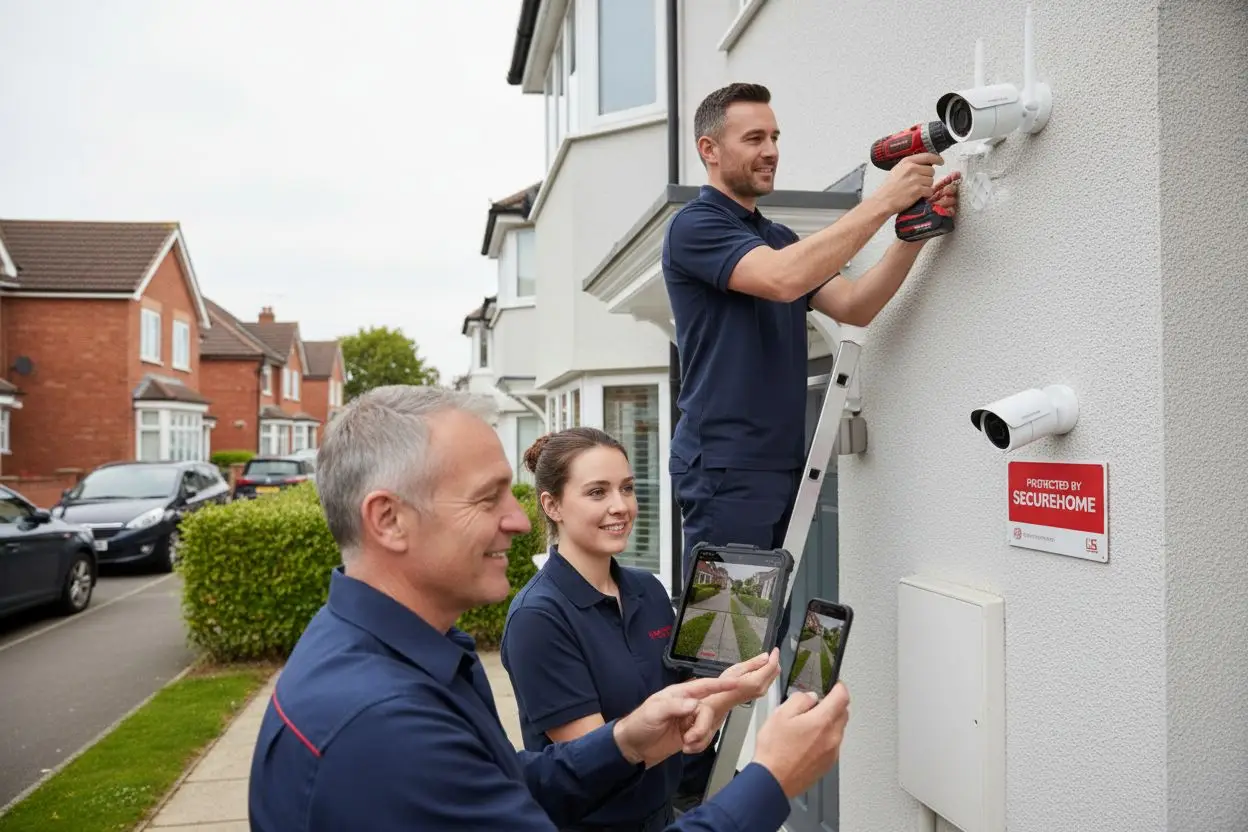Did you know that over 40 percent of UK households now rely on wireless CCTV systems for security? As more people look for flexible ways to safeguard their property, wireless cameras have surged in popularity thanks to simple installation and remote access. Whether you want to watch over your home or business, understanding how these systems work can help you make smarter choices about your safety and privacy.
Key Takeaways
| Point | Details |
|---|---|
| Modern Surveillance Solution | Wireless CCTV systems offer flexibility in installation and can operate without complex cabling, enhancing user convenience. |
| Variety of Configurations | Systems can be battery-powered, solar-powered, or hybrid, catering to different monitoring needs and installation preferences. |
| Legal Considerations | Compliance with UK laws is crucial; ensure proper signage and restrict recording to necessary areas to avoid privacy infringements. |
| Cost & Installation Insights | Initial costs range from £600 to £2,400 depending on property size; careful planning and installation are necessary to address signal challenges and ensure reliability. |
Table of Contents
- What Is Wireless CCTV Security?
- Types Of Wireless CCTV Systems
- How Wireless CCTV Systems Operate
- UK Laws On Wireless CCTV Installation
- Choosing, Installing, And Maintaining Wireless CCTV
- Costs, Limitations, And Common Mistakes
What Is Wireless CCTV Security?
Wireless CCTV security represents a modern solution for surveillance that delivers flexibility and convenience beyond traditional wired systems. Wireless security cameras transmit video and audio signals using radio frequencies, allowing property owners unprecedented monitoring capabilities without complex cable installations.
According to research from Wikipedia, these cameras typically operate through two primary configurations: partially wireless (requiring a power cable) and fully wireless (battery-powered). The key advantages include:
- Low installation costs
- Flexible camera placement options
- Quick setup and minimal structural disruption
- Remote monitoring capabilities
Outdoor wireless CCTV systems have become particularly sophisticated. Recent technical research indicates these systems now feature advanced technologies like:
- High-resolution video capture
- Weatherproof designs (IP65–IP67 ratings)
- Night vision capabilities
- Motion detection technology
- Two-way audio communication
- Flexible storage options (cloud and local)
Read our comprehensive guide on wireless vs wired alarm systems to understand how these modern security solutions compare to traditional setups and which might best suit your specific property protection needs.
Types of Wireless CCTV Systems
Wireless CCTV systems come in several distinct configurations, each offering unique capabilities for comprehensive security monitoring. Analog wireless systems and digital IP systems represent the two primary categories of wireless surveillance technologies.
According to research from Wikipedia, these systems fundamentally differ in how they transmit video and audio signals:
- Analog Wireless Systems: Transmit signals using traditional radio frequencies
- IP/Wi-Fi Systems: Send digital data over networked connections
The UK market offers an impressive range of innovative wireless CCTV solutions. Recent market research highlights three prominent wireless system types:

Here’s a comparison of the main types of wireless CCTV systems available in the UK:
| System Type | Power Source | Key Features |
|---|---|---|
| Battery-Powered | Batteries | Easy installation Long battery life HD video |
| Solar-Powered | Solar panel & batteries | Eco-friendly Human detection Low maintenance |
| 360° Solar Solution | Solar panel & batteries | Wide-angle coverage All-weather design Comprehensive monitoring |
- Battery-Powered Units: Like Blink Outdoor, featuring long battery life and HD video
- Solar-Powered Systems: Such as eufyCam with human detection capabilities
- 360° Solar Solutions: Providing comprehensive wide-angle coverage
Explore our detailed guide on key CCTV system features to understand how these different wireless technologies can be tailored to meet your specific security requirements.
How Wireless CCTV Systems Operate
Wireless CCTV systems provide sophisticated surveillance through advanced transmission technologies that enable flexible and remote monitoring. At their core, these systems leverage radio frequency bands to send video and audio signals from cameras to dedicated receivers without traditional wired connections.
According to Wikipedia, while the transmission is wireless, many cameras still require a wired power source unless they are battery-operated. This hybrid approach ensures consistent performance and reduces battery management complexities.
Research from technical sources reveals these systems typically operate through several key technological mechanisms:
Connecting via Wi-Fi or cellular networks
Providing live streaming access through mobile apps
Enabling remote monitoring via web portals
Incorporating advanced features like:
- Motion detection
- Cloud and local storage options
- Two-way audio communication
- Smart device integrations
Learn about our advanced IP CCTV installation techniques to understand how cutting-edge transmission technologies can enhance your security infrastructure and provide seamless, intelligent monitoring solutions.
UK Laws on Wireless CCTV Installation
Wireless CCTV installations in the UK are governed by strict legal frameworks designed to balance security needs with individual privacy rights. Understanding these regulations is crucial for responsible and compliant surveillance deployment.
According to Wikipedia, the Surveillance Camera Code of Practice under the Protection of Freedoms Act 2012 provides comprehensive guidelines for public and private CCTV use. This legislation emphasises three core principles:
- Responsible surveillance deployment
- Proportionate monitoring practices
- Accountable technology usage
Research from privacy experts highlights critical legal requirements for domestic CCTV systems:
- Record only necessary areas (strictly limited to your property)
- Avoid recording neighbours’ private spaces
- Restrict public area surveillance
- Display visible warning signage
- Limit data retention (typically 30 days)
- Respond promptly to subject access requests
Check out our comprehensive guide on CCTV camera placement to ensure your wireless security system meets all legal and ethical standards while protecting your property effectively.
Choosing, Installing, and Maintaining Wireless CCTV
Selecting the right wireless CCTV system requires careful consideration of your specific property requirements, budget, and potential security risks. Understanding the nuanced landscape of surveillance technology will help you make an informed investment in your property’s protection.
Research from security experts suggests evaluating your property’s unique characteristics when choosing a system. Typical UK installation costs vary significantly:
- Small home: £600–£1,000 total system cost
- Medium property: £1,000–£1,500 total system cost
- Large property: £1,500–£2,400 total system cost
Technical analysis from CCTV specialists reveals important considerations for wireless system reliability:
- Potential signal interference on standard 2.4 GHz/5.8 GHz bands
- Licensed higher-power systems are available but expensive
- Wired solutions (like CAT5 with baluns) offer more consistent long-range connections
- Consider hybrid wired/wireless approaches for maximum reliability
Learn more about strategic CCTV camera placement to ensure your wireless system provides comprehensive coverage while maintaining optimal performance and minimising potential signal disruptions.
Costs, Limitations, and Common Mistakes
Understanding the financial investment and potential challenges of wireless CCTV systems is crucial for making informed security decisions. While these technologies offer remarkable flexibility, they also come with specific considerations that can impact their effectiveness and overall value.
Research from security specialists confirms the expected investment ranges for UK properties:
- Small home systems: £600–£1,000
- Medium home systems: £1,000–£1,500
- Large home systems: £1,500–£2,400
Technical analysis from CCTV experts highlights critical limitations and common installation mistakes:
- Potential interference on shared wireless frequencies
- Lower quality components in budget systems
- Misleading manufacturer range claims
- DIY installation risks including:
- Improper lens selection
- Signal transmission problems
- Potential legal non-compliance
Discover our comprehensive guide on strategic camera placement to help you navigate these challenges and ensure a reliable, legally compliant wireless CCTV system for your property.
Take the Worry Out of Wireless CCTV with Professional Security Support
Are you unsure about choosing the right wireless CCTV system for your property? The article highlighted common frustrations such as signal reliability, confusing setup, and staying compliant with UK laws. Many home and business owners find themselves overwhelmed with choices and fear their investment will not provide the security or legal peace of mind they need. At 247 CCTV, we understand these concerns and specialise in making security simple and effective for both residential and business customers.

Let us handle every detail of your security installation, from selecting advanced wireless cameras to ensuring proper placement and legal compliance. Your safety deserves a fully custom and dependable solution. Visit our main website to request a tailored quote or explore our IP CCTV installation expertise for advanced needs. Secure your property now to enjoy true peace of mind and professional support every step of the way.
Frequently Asked Questions
What are the main types of wireless CCTV systems?
Wireless CCTV systems can be categorized into two primary types: analog wireless systems, which transmit signals using traditional radio frequencies, and IP/Wi-Fi systems, which send digital data over networked connections.
How do wireless CCTV systems operate?
Wireless CCTV systems operate by using radio frequency bands to transmit audio and video signals from cameras to receivers without the need for physical cables. Many cameras require a wired power source unless they are battery-operated.
What are the key features to look for in a wireless CCTV system?
Key features to consider include high-resolution video capture, weatherproof designs, night vision capabilities, motion detection technology, two-way audio communication, and flexible storage options (cloud and local).
What are the legal requirements for installing wireless CCTV in the UK?
In the UK, the legal requirements for installing wireless CCTV include recording only necessary areas, avoiding surveillance of neighbors’ private spaces, displaying visible warning signage, limiting data retention, and responding promptly to access requests.

